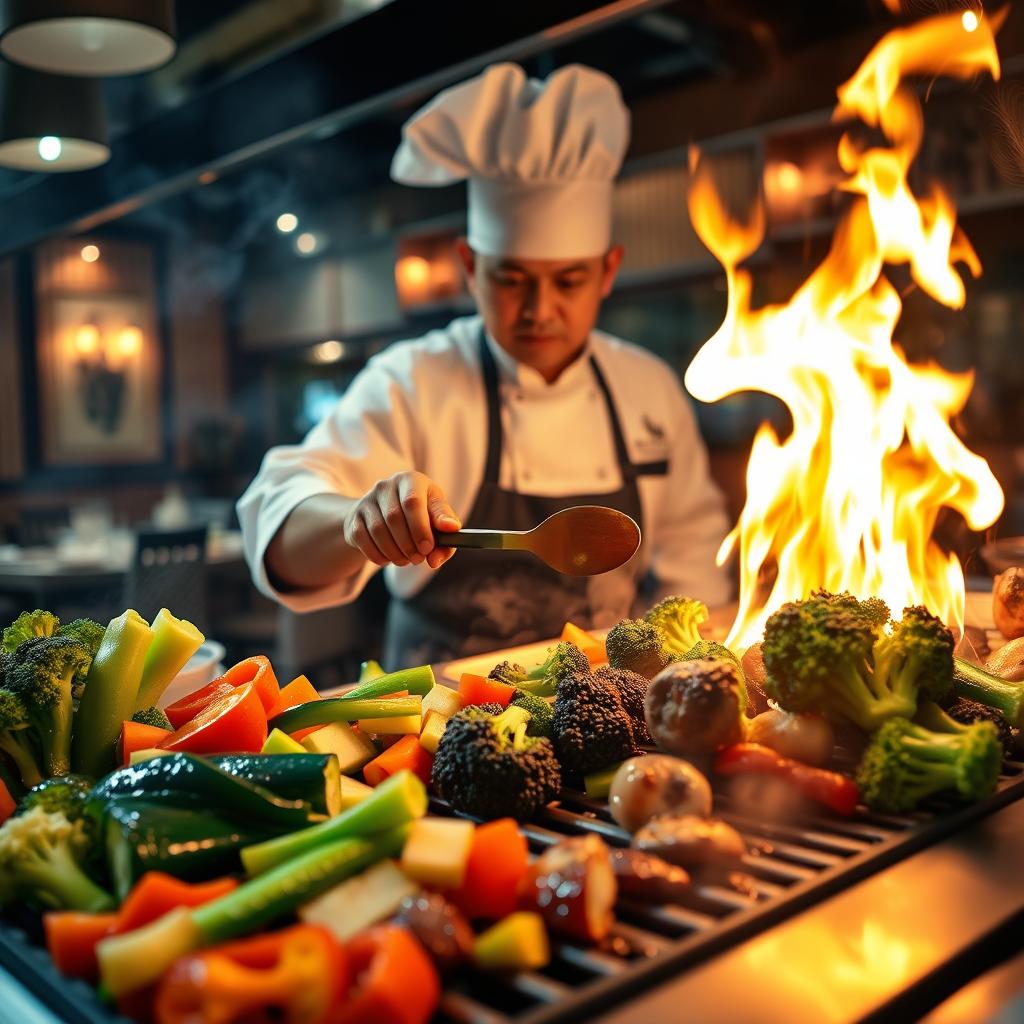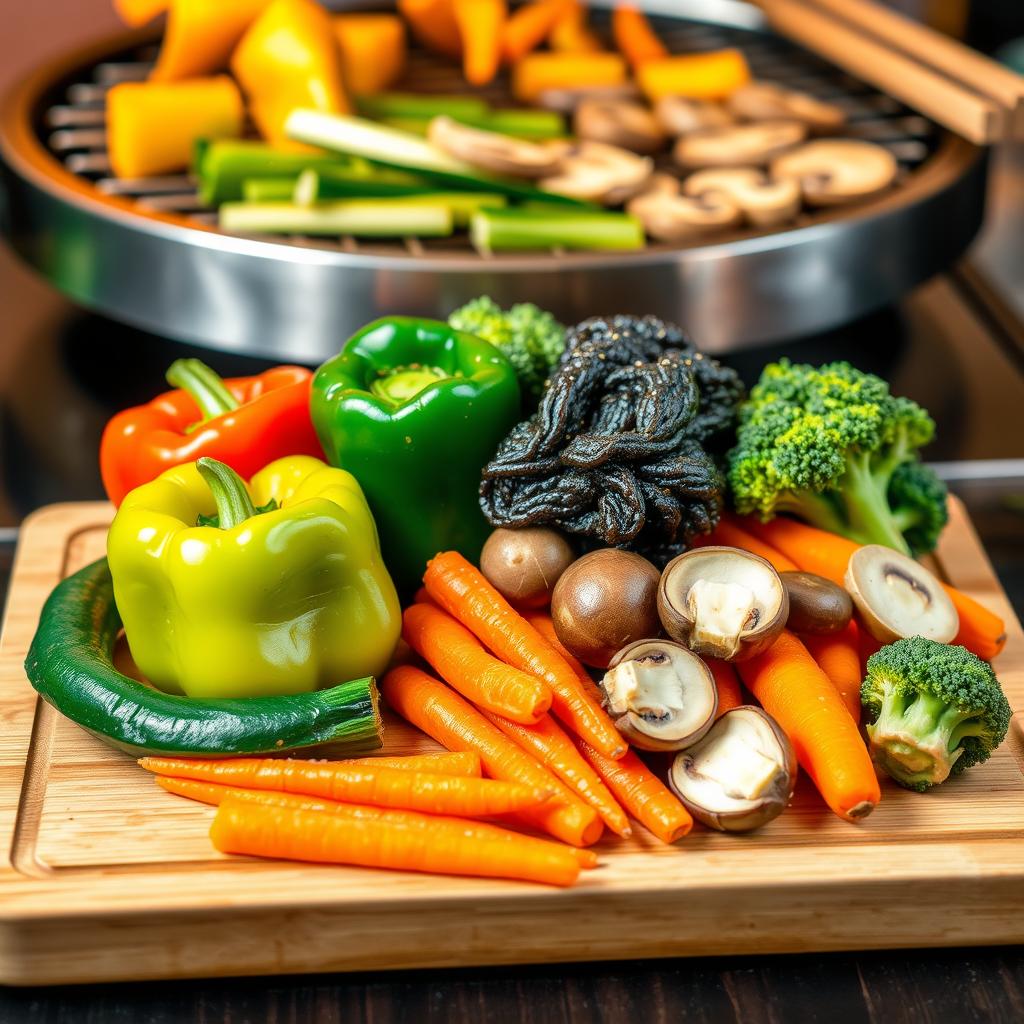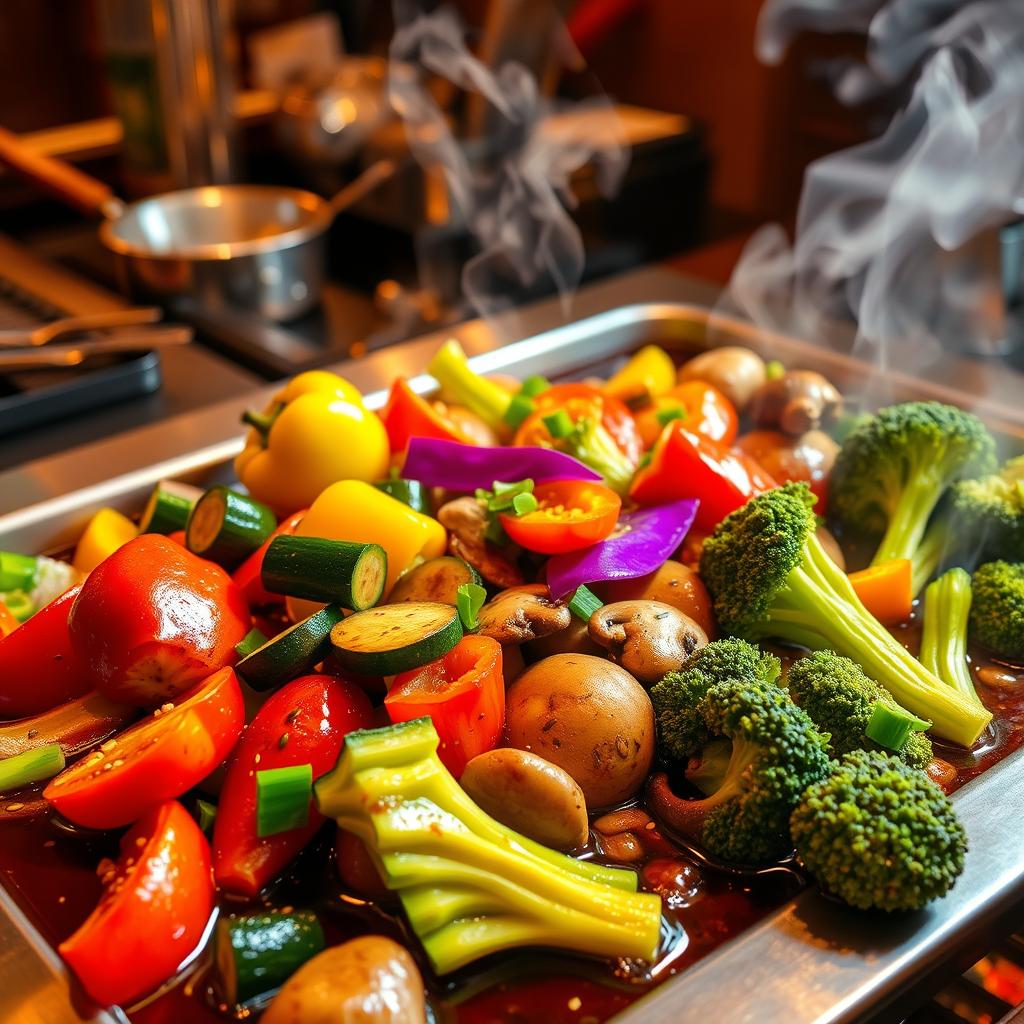Want a meal that’s both tasty and healthy? Look no further. Our hibachi vegetables recipe is here to satisfy your cravings. It turns simple veggies into a Japanese-style feast right in your kitchen.
Grilling veggies on a flat iron surface adds a unique flavor. It’s so good, you’ll forget about boring side dishes. With a few tricks, you can make a grilled vegetable medley that’s as good as a pro’s.
Hibachi veggies are not just tasty; they’re also healthy. They keep nutrients in while getting a great caramelized taste. This recipe is perfect for anyone, whether you’re new to cooking or a seasoned pro.
Key Takeaways
- Learn authentic Japanese-style vegetable cooking techniques
- Create restaurant-quality meals at home
- Enjoy a nutritious and flavorful dish
- Master easy hibachi cooking methods
- Transform simple vegetables into gourmet cuisine
Understanding the Art of Hibachi-Style Cooking
Explore the world of hibachi cooking, where vegetables meet art. This Japanese technique turns simple veggies into a sizzling delight. It’s a feast for your taste and imagination.

Hibachi cooking is more than cooking. It’s a show that brings food to life. It started with Japanese heating devices and grew into a cooking style that’s both tasty and entertaining.
The History of Teppanyaki and Hibachi Traditions
Hibachi cooking has deep roots in Japanese culture. It began with simple heating devices for warmth. Chefs turned these into interactive cooking platforms, loved worldwide.
- Originated in Japan during the Edo period
- Initially used as heating devices
- Evolved into a unique cooking method
- Popularized internationally in the mid-20th century
Essential Equipment for Hibachi Cooking at Home
To cook like a pro at home, you need the right tools. Your kitchen should have a flat-top griddle, heat-resistant utensils, and precise tools.
| Equipment | Purpose | Recommended Type |
|---|---|---|
| Flat-top Griddle | Main Cooking Surface | Cast Iron or Stainless Steel |
| Cooking Spatulas | Vegetable Manipulation | Long-handled, Heat-resistant |
| High-Heat Oils | Cooking Medium | Sesame or Vegetable Oil |
Temperature Control Techniques
Mastering hibachi cooking means controlling heat. You aim for perfect cooking and flavor. It’s all about the timing and heat zones.
“The secret to great hibachi vegetables is understanding your heat zones and timing.” – Professional Hibachi Chef
With these techniques, you’ll make ordinary veggies into a spectacular dish. It will wow your guests and satisfy your taste buds.
Best Vegetables for Your Hibachi Experience
Creating the perfect teriyaki vegetable skewers begins with picking the right vegetables. Your hibachi journey is all about choosing ingredients that taste amazing and look great too.

The best yakisoba vegetable mix has veggies with different textures and cooking times. Aim to make a benihana-style veggie dish that’s exciting to see and eat.
- Crisp Vegetables:
- Bell peppers (red, green, yellow)
- Zucchini
- Onions
- Tender Vegetables:
- Mushrooms
- Asparagus
- Baby corn
Your veggie choices should balance flavors and cooking times. Not all vegetables cook at the same rate. So, it’s important to plan how you’ll cook them.
“The secret to great hibachi vegetables is understanding each ingredient’s unique cooking profile.” – Culinary Experts
| Vegetable | Cooking Time | Flavor Profile |
|---|---|---|
| Bell Peppers | 3-4 minutes | Sweet, slightly charred |
| Mushrooms | 4-5 minutes | Earthy, umami |
| Zucchini | 2-3 minutes | Mild, tender |
When making your teriyaki vegetable skewers, remember variety is key. Mix different veggies to make a colorful, tasty benihana-style veggie dish. It will surely wow everyone at the table.
Essential Ingredients and Seasonings for Authentic Flavor
Unlocking the magic of hibachi cooking is all about the right ingredients. These ingredients turn simple garlic butter roasted veggies into a masterpiece. The perfect seasonings and sauces can make your vegetable dishes truly spectacular.
Classic Hibachi Sauce Components
Choosing the right vegetables for hibachi is key. But pairing them with the perfect sauce is even more important. Traditional hibachi sauces usually include:
- Soy sauce
- Sesame oil
- Mirin (sweet rice wine)
- Ginger
- Garlic
Special Seasoning Blends and Marinades
Hibachi chefs have secrets for amazing flavors. They often mix:
- Teriyaki-style marinades
- Sake-based seasonings
- Butter and soy sauce reductions
“The magic of hibachi cooking is in the simplicity of ingredients and the complexity of flavor” – Master Hibachi Chef
Where to Source Traditional Japanese Ingredients
To find out what hibachi chefs squirt on veggies, check these places:
- Asian specialty markets
- Online Japanese grocery stores
- Well-stocked supermarket international sections
Pro tip: Fresh ingredients are crucial for authentic hibachi-style vegetable dishes.
Step-by-Step Hibachi Vegetables Recipe
Making tasty hibachi vegetables at home is simple. The secret is a mix of seasonings and techniques. These turn basic ingredients into a dish you’ll love.
- Mixed vegetables (zucchini, onions, mushrooms, bell peppers)
- Soy sauce
- Sesame oil
- Butter
- Salt and pepper
What seasoning do they use for hibachi? It’s a special mix of Japanese flavors that makes the taste unforgettable.
“Hibachi cooking is an art of simplicity and precision” – Japanese Culinary Masters
Here’s how to make real hibachi vegetables:
- Chop veggies into small, even pieces
- Heat a flat griddle or big skillet to high
- Add butter and sesame oil
- Stir-fry veggies fast
- Season with soy sauce, salt, and pepper
Pro tip: The secret of hibachi cooking is using high heat quickly. This keeps veggies crisp and flavorful.
| Vegetable | Cooking Time | Seasoning Recommendation |
|---|---|---|
| Zucchini | 2-3 minutes | Sesame oil, light soy sauce |
| Mushrooms | 3-4 minutes | Butter, garlic salt |
| Onions | 2 minutes | Cracked black pepper |
Serve right away for the best hibachi taste!
Master Chef Tips for Perfect Vegetable Preparation
Mastering hibachi-style vegetable cooking is more than basic kitchen skills. Professional chefs use special techniques to make simple ingredients amazing. Knowing what’s in traditional hibachi helps you cook like a pro.
Hibachi cooking is all about precision and art. So, why is hibachi food so great? It’s because of the technique, timing, and expert preparation.
Cutting Techniques for Even Cooking
Uniform vegetable cuts are key for perfect hibachi dishes. Here are some pro tips:
- Use a sharp knife for precise, consistent cuts
- Cut vegetables into similar-sized pieces
- Create diagonal cuts for larger surface area
- Practice julienne and medium-dice techniques
Timing and Heat Management Secrets
Controlling heat is an art in hibachi cooking. Professional chefs suggest:
- Preheat your cooking surface to high temperature
- Cook vegetables in small batches
- Keep vegetables moving to prevent burning
- Use minimal oil for authentic flavor
Professional Plating Methods
“Presentation is as important as taste in hibachi cooking” – Chef Masaharu Morimoto
Create stunning plates by:
- Using white plates to highlight vegetable colors
- Arranging vegetables in artistic patterns
- Garnishing with fresh herbs
- Adding a drizzle of sauce for extra appeal
With these pro techniques, you’ll turn ordinary vegetables into a spectacular hibachi feast. It will wow both your eyes and taste buds.
Secret Sauce Recipes and Flavor Enhancements
Take your hibachi vegetables recipe to the next level with these amazing sauce secrets. They turn a simple grilled vegetable medley into a true culinary masterpiece. The key to a perfect teppanyaki veggie stir fry is using the right sauces.
“Great sauces are the heartbeat of hibachi cooking – they turn ordinary vegetables into extraordinary experiences.”
Discover the flavors of authentic Japanese-inspired sauces with these signature recipes:
- Classic Yum Yum Sauce
- Mayonnaise base
- Tomato paste
- Garlic powder
- Paprika
- Ginger Sesame Drizzle
- Fresh grated ginger
- Sesame oil
- Soy sauce
- Rice vinegar
Your grilled vegetable medley needs amazing flavor. The secret is finding the right mix of sweet, tangy, and umami. This balance brings out the best in your hibachi vegetables.
Professional chefs say to play with sauce ratios to make your teppanyaki veggie stir fry special. Begin with small batches and tweak until it’s just right for you.
“Sauce is not just a condiment – it’s the soul of your dish.”
Pro tip: Make sauces ahead of time and chill them. This lets the flavors blend together. It makes your hibachi-style vegetable dishes even more delicious.
Common Mistakes to Avoid When Cooking Hibachi Style
Mastering japanese steakhouse vegetables is more than just wanting to do well. Even skilled cooks can face challenges when trying to make that perfect dish. Knowing what to avoid can improve your hibachi cooking skills.
Cooking hibachi-style vegetables is an art that needs precision and practice. Knowing what to avoid can turn your cooking from okay to outstanding.
Temperature Control Challenges
Getting the right heat is key for your fire-roasted vegetable blend. Many home cooks face big mistakes when managing cooking temperatures:
- Overheating the cooking surface, which burns vegetables
- Using inconsistent heat zones
- Not preheating the cooking surface properly
Ingredient Selection Mistakes
Picking the right vegetables is crucial for a great hibachi experience. Avoid these common ingredient errors:
- Choosing vegetables with different cooking times
- Using moisture-heavy vegetables that prevent proper searing
- Neglecting to prepare ingredients in advance
Timing and Sequence Problems
Proper sequencing is key when preparing japanese steakhouse vegetables. Professional chefs know that timing affects flavor and texture.
“The secret to great hibachi cooking is rhythm and respect for each ingredient’s unique characteristics.” – Chef Masaharu Morimoto
By avoiding these common mistakes, you’ll be well on your way to creating restaurant-quality hibachi vegetables at home.
Pairing Your Hibachi Vegetables with Other Dishes
Creating a delicious hibachi-inspired meal is more than just veggies. Your teriyaki vegetable skewers can turn a simple dinner into a fun food adventure. This happens when you pair them with the right dishes.
- Grilled chicken or shrimp for a protein boost
- Steamed white rice with sesame seeds
- Miso soup as a light starter
- Crispy tempura vegetables
A benihana-style veggie dish is even more amazing with the right sides. Garlic fried rice adds a savory touch to your colorful veggies.
“The art of hibachi cooking is about creating harmony on the plate”
Pro tip: Mix different textures and flavors in your meal. The goal is to have a plate that keeps your taste buds happy with every bite.
Health Benefits and Nutritional Information
Hibachi vegetables are packed with nutrients, unlike regular cooking methods. Garlic butter roasted veggies in the hibachi style are tasty and nutritious. The high heat cooking keeps vitamins and minerals intact, adding flavor.
“Eating vegetables is like giving your body a natural multivitamin,” nutrition experts often say.
Choosing the right vegetables for hibachi is key. Zucchini, bell peppers, onions, and mushrooms are great. They taste good and are full of nutrients.
- Nutrient Highlights of Hibachi Vegetables:
- High in antioxidants
- Low-calorie option
- Rich in essential vitamins
- Supports healthy digestion
Hibachi chefs have a secret for veggies. They use butter, soy sauce, and sometimes sesame oil. This mix boosts flavor and nutrition.
| Vegetable | Calories | Key Nutrients |
|---|---|---|
| Zucchini | 20 per cup | Vitamin C, Potassium |
| Bell Peppers | 30 per cup | Vitamin A, Vitamin C |
| Mushrooms | 15 per cup | Selenium, B Vitamins |
Pro tip: The hibachi cooking method helps retain more nutrients compared to traditional boiling or steaming, making it an excellent choice for health-conscious food lovers.
Conclusion
Learning to make hibachi vegetables is more than cooking. It’s about making meals special. Your new skills in teppanyaki veggie stir fry will wow everyone, making your kitchen feel like a restaurant.
With time, you’ll get better at grilling veggies that are both healthy and tasty. Try different veggies, seasonings, and methods to find your own style. For more plant-based recipe ideas, check out this link.
Cooking is a never-ending learning process. Every time you cook hibachi veggies, you’ll get better and more confident. Don’t be shy to add your own twist to traditional recipes. That’s where the real magic is.
Your kitchen is now your own hibachi grill. Enjoy the thrill, the flavors, and the world of Japanese cooking you’ve discovered.
FAQ
What vegetables work best for hibachi-style cooking?
Great choices for hibachi include zucchini, bell peppers, onions, mushrooms, and broccoli. These veggies are tough enough for high heat and soak up flavors well. Mix different colors and textures for a tasty and pretty dish.
What is the secret ingredient in authentic hibachi seasoning?
Garlic butter and a mix of soy sauce, sesame oil, and sake or mirin are key. Hibachi chefs also add salt, pepper, and sometimes ginger to boost flavors.
How do hibachi chefs get such amazing flavor in their vegetables?
Chefs use high heat, precise cuts, and seasonings like soy sauce and butter. They also sear the veggies quickly to lock in flavors. This mix creates the unique hibachi taste.
Can I make hibachi vegetables if I don’t have a teppanyaki grill?
Yes! Use a cast-iron skillet, flat griddle, or large non-stick pan. High heat and quick cooking keep the veggies crisp and flavorful.
What type of oil is best for hibachi-style vegetable cooking?
Sesame oil and vegetable oil are top picks. Sesame oil adds a unique Asian taste, while vegetable oil cooks evenly. Many chefs mix both for the best flavor and cooking.
Are hibachi vegetables healthy?
Absolutely! Hibachi veggies are packed with nutrients, low in oil, and cooked fast. This method keeps their vitamins and minerals while adding tasty seasonings.
What sauce do hibachi chefs typically use on vegetables?
Chefs often use soy sauce, butter, and sometimes teriyaki sauce. They mix these to create a flavorful sauce that coats the veggies and adds a glossy finish.
How long should I cook vegetables for hibachi-style preparation?
Cook veggies for 2-4 minutes for a nice char and crisp texture. Broccoli might take a bit longer, while mushrooms cook faster.

